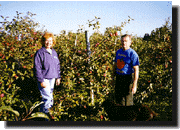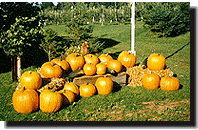
The proliferation of strawberry “U-Picks” is
a testimony to the popularity and success of fruit
production in Prince Edward Island. In July, a trip down
a road along a strawberry field is bound to be punctuated
by dozens of Island bodies, young and old, crouched
between rows of strawberry plants, arms reaching among
the bright green leaves to fill giant buckets with the
plump, juicy, red berries that will eventually find their
way into pies and preserves—as long as they do not
go directly into bellies first!
 The
most important fruits grown on the Island are
strawberries and blueberries, with revenues from these
two crops exceeding $2 million annually as of 1990. In
1997, there were 56 farm operations involved in the
production of fruits such as apples, pears, sweet
cherries, sour cherries, peaches, apricots, plums,
prunes, berries, and grapes. Apple groves represent the
largest number of fruit-growing operations. There were 26
apple growers in Prince Edward Island in 1997.
The
most important fruits grown on the Island are
strawberries and blueberries, with revenues from these
two crops exceeding $2 million annually as of 1990. In
1997, there were 56 farm operations involved in the
production of fruits such as apples, pears, sweet
cherries, sour cherries, peaches, apricots, plums,
prunes, berries, and grapes. Apple groves represent the
largest number of fruit-growing operations. There were 26
apple growers in Prince Edward Island in 1997.
 Many
other fruit and vegetable crops are grown in smaller
scale operations that take advantage of the lower costs
of production and the ease of growing mixed vegetables
economically on a small acreage. In 1997, there were 167
farms (excluding greenhouse operations) producing
vegetables for sale. This type of production, while
economical, is labour-intensive and requires a good
knowledge of horticulture. Cole crops and root vegetables
(see below) grow especially well in Prince Edward
Island’s sandy loam and cool, moist climate. These
crops account for the majority of vegetable revenues for
the 54 vegetable farms on the Island.
Many
other fruit and vegetable crops are grown in smaller
scale operations that take advantage of the lower costs
of production and the ease of growing mixed vegetables
economically on a small acreage. In 1997, there were 167
farms (excluding greenhouse operations) producing
vegetables for sale. This type of production, while
economical, is labour-intensive and requires a good
knowledge of horticulture. Cole crops and root vegetables
(see below) grow especially well in Prince Edward
Island’s sandy loam and cool, moist climate. These
crops account for the majority of vegetable revenues for
the 54 vegetable farms on the Island.
Vegetable growers on the Island
market their produce either to wholesalers or directly to
consumers. Those producing for wholesalers are most
likely to specialize in only a few crops. This
specialization, combined with larger acreages under
production, usually allows growers to rely more on
machinery than hired labour. Producers marketing
“farm-fresh produce” directly to  consumers are most
likely to be small, family-run operations selling from
local farmer’s markets or roadside stands. Most
frequently, these farms owe their success to
long-standing reputations; many years spent building
relationships with repeat customers, and responsiveness
to ever-changing demands. Vegetable crops can be grouped
into ten categories:
consumers are most
likely to be small, family-run operations selling from
local farmer’s markets or roadside stands. Most
frequently, these farms owe their success to
long-standing reputations; many years spent building
relationships with repeat customers, and responsiveness
to ever-changing demands. Vegetable crops can be grouped
into ten categories:
1. Perennial crops: asparagus, rhubarb, Jerusalem
artichoke.
2. Potherbs or greens: spinach, collards.
3. Salad crops: celery, lettuce, parsley, endive.
4. Cole crops: cabbage, cauliflower, broccoli,
Brussels sprouts, Chinese cabbage, kohlrabi.
5. Root crops: beets, carrots, parsnips, rutabaga,
radish.
6. Bulb crops: onion, leek, garlic.
7. Pulse crops: peas, beans (snap and dry).
8. Solaneceous fruits: tomatoes, eggplant, pepper.
9. Cucurbits or vine crops: cucumber, muskmelon,
pumpkin, squash, melons.
10. Sweet corn.
Beekeeping, greenhouse operations and bedding plants
production offer a fine complement to fruit and vegetable
growing on the Island. In 1997, there were 53 greenhouse
operations and mushroom growers as well as 22 nursery
operators and sod producers in the province.
Potatoes | Field Crops | Beef and Dairy | Swine
Poultry and Eggs | Emerging Commodities |
Beekeeping
